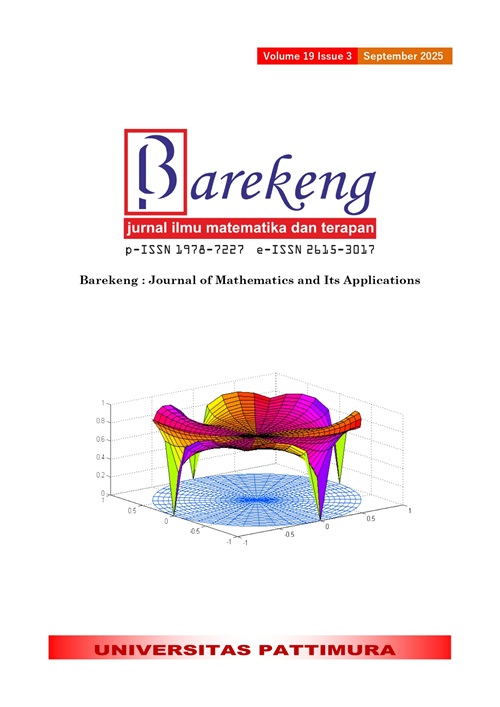NONLINEAR TRACKING CONTROL FOR PREY STABILIZATION IN PREDATOR-PREY MODEL USING BACKSTEPPING
Abstract
The common method used in population dynamics is optimal control, which employs Pontryagin’s minimum principle. This method minimizes costs, with the constraint function being the model dynamics. Unfortunately, if the main objective of the control function is to modify the population’s behavior to follow a specific pattern, this method is challenging to apply. This article introduces a control function to the predator-prey model for the tracking problem using the backstepping method. The control function drives the population from the initial value towards the given trajectory. The goal is to maintain the balance between predator and prey populations in the habitat, with the chosen trajectory being the equilibrium point. The application of backstepping to the predator-prey model is combined with input-output feedback linearization to obtain a normal form, enabling the implementation of backstepping. Simulation results show that the controller successfully drives the predator-prey populations toward the equilibrium point with a relatively small control function and excellent performance.
Downloads
References
R. Friedman, ‘A HIERARCHY OF INTERACTIONS BETWEEN PATHOGENIC VIRUS AND VERTEBRATE HOST’, Symmetry, vol. 14, no. 11, Art. no. 11, Nov. 2022, doi: https://doi.org/10.3390/sym14112274.
A. J. Lotka, ‘ANALYTICAL NOTE ON CERTAIN RHYTHMIC RELATIONS IN ORGANIC SYSTEMS’, Proc. Natl. Acad. Sci., vol. 6, no. 7, pp. 410–415, Jul. 1920, doi: https://doi.org/10.1073/pnas.6.7.410.
S. Kekulthotuwage Don, K. Burrage, K. J. Helmstedt, and P. M. Burrage, ‘STABILITY SWITCHING IN LOTKA-VOLTERRA AND RICKER-TYPE PREDATOR-PREY SYSTEMS WITH ARBITRARY STEP SIZE’, Axioms, vol. 12, no. 4, Art. no. 4, Apr. 2023, doi: https://doi.org/10.3390/axioms12040390.
P. Mishra and D. Wrzosek, ‘PURSUIT-EVASION DYNAMICS FOR BAZYKIN-TYPE PREDATOR-PREY MODEL WITH INDIRECT PREDATOR TAXIS’, J. Differ. Equ., vol. 361, pp. 391–416, Jul. 2023, doi: https://doi.org/10.1016/j.jde.2023.02.063.
W. Choi, K. Kim, and I. Ahn, ‘PREDATOR-PREY MODELS WITH PREY-DEPENDENT DIFFUSION ON PREDATORS IN SPATIALLY HETEROGENEOUS HABITAT’, J. Math. Anal. Appl., vol. 525, no. 1, p. 127130, Sep. 2023, doi: https://doi.org/10.1016/j.jmaa.2023.127130.
M. S. Arif, K. Abodayeh, and A. Ejaz, ‘STABILITY ANALYSIS OF FRACTIONAL-ORDER PREDATOR-PREY SYSTEM WITH CONSUMING FOOD RESOURCE’, Axioms, vol. 12, no. 1, Art. no. 1, Jan. 2023, doi: https://doi.org/10.3390/axioms12010064.
D. Mukherjee and C. Maji, ‘BIFURCATION ANALYSIS OF A HOLLING TYPE II PREDATOR-PREY MODEL WITH REFUGE’, Chin. J. Phys., vol. 65, pp. 153–162, Jun. 2020, doi: https://doi.org/10.1016/j.cjph.2020.02.012.
M. Rayungsari, A. Suryanto, W. M. Kusumawinahyu, and I. Darti, ‘DYNAMICAL ANALYSIS OF A PREDATOR-PREY MODEL INCORPORATING PREDATOR CANNIBALISM AND REFUGE’, Axioms, vol. 11, no. 3, Art. no. 3, Mar. 2022, doi: https://doi.org/10.3390/axioms11030116.
M. Manaqib, S. Suma’inna, and A. Zahra, ‘MATHEMATICAL MODEL OF THREE SPECIES FOOD CHAIN WITH INTRASPECIFIC COMPETITION AND HARVESTING ON PREDATOR’, BAREKENG J. Ilmu Mat. Dan Terap., vol. 16, no. 2, pp. 551–562, Jun. 2022, doi: https://doi.org/10.30598/barekengvol16iss2pp551-562.
M. K. Dewi, D. Savitri, and A. Abadi, ‘DYNAMICAL BEHAVIOR IN THE COMPETITIVE MODEL INCORPORATING THE FEAR EFFECT OF PREY DUE TO ALLELOPATHY WITH SHARED BIOTIC RESOURCES’, BAREKENG J. Ilmu Mat. Dan Terap., vol. 18, no. 4, pp. 2663–2674, Oct. 2024, doi: https://doi.org/10.30598/barekengvol18iss4pp2663-2674.
K. P. Wijaya et al., ‘FOOD SHARING AND TIME BUDGETING IN PREDATOR-PREY INTERACTION’, Commun. Nonlinear Sci. Numer. Simul., vol. 97, p. 105757, Jun. 2021, doi: https://doi.org/10.1016/j.cnsns.2021.105757.
K. Mu’tamar, D. Rahmalia, and Sutimin, ‘VAKSINASI DAN TREATMENT PADA PREDATOR-PREY DENGAN DUA JENIS PEMANGSA YANG SALAH SATUNYA TERINFEKSI’, EKSAKTA J. Sci. Data Anal., pp. 128–142, Aug. 2019, doi: https://doi.org/10.20885/eksakta.vol19.iss2.art4.
D. De La Rosa Romo, R. Loera-Palomo, M. Rivero, and F. S. Sellschopp-Sánchez, ‘AVERAGED CURRENT MODE CONTROL FOR MAXIMUM POWER POINT TRACKING IN HIGH-GAIN PHOTOVOLTAIC APPLICATIONS’, J. Power Electron., vol. 20, no. 6, pp. 1650–1661, Nov. 2020, doi: https://doi.org/10.1007/s43236-020-00144-1.
M. Madark, A. Ba-razzouk, E. Abdelmounim, and M. E. Malah, ‘ADAPTIVE BACKSTEPPING CONTROL OF INDUCTION MOTOR POWERED BY PHOTOVOLTAIC GENERATOR’, Int. J. Electr. Comput. Eng., vol. 11, no. 4, pp. 2842–2855, 2021, doi: https://doi.org/10.11591/ijece.v11i4.pp2842-2855.
N. Koksal, H. An, and B. Fidan, ‘BACKSTEPPING-BASED ADAPTIVE CONTROL OF A QUADROTOR UAV WITH GUARANTEED TRACKING PERFORMANCE’, ISA Trans., vol. 105, pp. 98–110, Oct. 2020, doi: https://doi.org/10.1016/j.isatra.2020.06.006.
A. Bouchaib, R. Taleb, A. Massoum, and S. Mekhilef, ‘GEOMETRIC CONTROL OF QUADROTOR UAVS USING INTEGRAL BACKSTEPPING’, Indones. J. Electr. Eng. Comput. Sci., vol. 22, no. 1, pp. 53–61, Apr. 2021, doi: https://doi.org/10.11591/ijeecs.v22.i1.pp53-61.
F. Wang, Y. Gao, C. Zhou, and Q. Zong, ‘DISTURBANCE OBSERVER-BASED BACKSTEPPING FORMATION CONTROL OF MULTIPLE QUADROTORS WITH ASYMMETRIC OUTPUT ERROR CONSTRAINTS’, Appl. Math. Comput., vol. 415, p. 126693, Feb. 2022, doi: https://doi.org/10.1016/j.amc.2021.126693.
M. Zubair, I. Ahmad, and Y. Islam, ‘BACKSTEPPING AND SYNERGETIC CONTROLLERS FOR THE CHEMOTHERAPY OF BRAIN TUMOR’, Int. J. Control Autom. Syst., vol. 19, no. 7, pp. 2544–2556, Jul. 2021, doi: https://doi.org/10.1007/s12555-020-0426-5.
K. Mu’tamar, J. Naiborhu, and R. Saragih, ‘DESAIN KONTROL PENGOBATAN PADA MODEL SIRD UNTUK PENYEBARAN VIRUS COVID-19 MENGGUNAKAN BACKSTEPPING’, BAREKENG J. Ilmu Mat. Dan Terap., vol. 15, no. 4, pp. 697–708, Dec. 2021, doi: https://doi.org/10.30598/barekengvol15iss4pp697-708.
K. Mu’tamar, J. Naiborhu, and R. Saragih, ‘VACCINATION ON SIR MODEL OF COVID-19 USING BACKSTEPPING CONTROL’, in AIP Conf. Proc, Banda Aceh, Indonesia, May 2023. doi: https://doi.org/10.1063/5.0103444.
K. Mu`tamar, J. Naiborhu, and R. Saragih, ‘STABILIZING NONMINIMUM-PHASE BILINEAR CONTROL SYSTEM USING BACKSTEPPING-SLIDING MODE CONTROL’, in 2022 10th International Conference on Control, Mechatronics and Automation (ICCMA), Belval, Luxembourg: IEEE, Nov. 2022, pp. 116–121. doi: https://doi.org/10.1109/ICCMA56665.2022.10011597.
K. Mu’tamar, J. Naiborhu, R. Saragih, and D. Handayani, ‘TRACKING CONTROL DESIGN FOR A BILINEAR CONTROL SYSTEM WITH UNSTABLE AND UNCERTAIN INTERNAL DYNAMICS USING ADAPTIVE BACKSTEPPING’, Int. J. Control Autom. Syst., vol. 22, no. 9, pp. 2758–2768, Sep. 2024, doi: https://doi.org/10.1007/s12555-023-0301-2.
K. Mu`tamar, J. Naiborhu, R. Saragih, and D. Handayani, ‘TRACKING CONTROL FOR PLANAR NONMINIMUM-PHASE BILINEAR CONTROL SYSTEM WITH DISTURBANCE USING BACKSTEPPING’, Indones. J. Electr. Eng. Comput. Sci., vol. 26, no. 3, p. 1315, Jun. 2022, doi: https://doi.org/10.11591/ijeecs.v26.i3.pp1315-1327.
K. Mu’tamar, J. Naiborhu, R. Saragih, and D. Handayani, ‘TRACKING CONTROL FOR UNCERTAIN BILINEAR CONTROL SYSTEM USING BACKSTEPPING METHOD’, AIP Conf. Proc., vol. 2867, no. 1, p. 020009, Oct. 2024, doi: https://doi.org/10.1063/5.0237275.
M. Zhang and L. Zhang, ‘AN OPTIMAL CONTROL PROBLEM FOR A BIOLOGICAL POPULATION MODEL WITH DIFFUSION AND INFECTIOUS DISEASE’, Eur. J. Control, vol. 72, p. 100821, Jul. 2023, doi: https://doi.org/10.1016/j.ejcon.2023.100821.
T. L. Vincent, C. S. Lee, H. R. Pulliam, and L. G. Everett, ‘APPLICATIONS OF OPTIMAL CONTROL TO THE MODELING AND MANAGEMENT OF ECOSYSTEMS’, SIMULATION, vol. 24, no. 3, pp. 65–72, Mar. 1975, doi: https://doi.org/10.1177/003754977502400301.
B. S. Goh, G. Leitmann, and T. L. Vincent, ‘OPTIMAL CONTROL OF A PREY-PREDATOR SYSTEM’, Math. Biosci., vol. 19, no. 3–4, pp. 263–286, Apr. 1974, doi: https://doi.org/10.1016/0025-5564(74)90043-1.
M. Zhou and H. Xiang, ‘OPTIMAL CONTROL PROBLEMS OF A REACTION–DIFFUSION ECOLOGICAL MODEL WITH A PROTECTION ZONE’, J. Process Control, vol. 120, pp. 97–114, Dec. 2022, doi: https://doi.org/10.1016/j.jprocont.2022.10.008.
M. Mukherjee, D. Pal, S. K. Mahato, and E. Bonyah, ‘PREY–PREDATOR OPTIMAL HARVESTING MATHEMATICAL MODEL IN THE PRESENCE OF TOXIC PREY UNDER INTERVAL UNCERTAINTY’, Sci. Afr., vol. 21, p. e01837, Sep. 2023, doi: https://doi.org/10.1016/j.sciaf.2023.e01837.
S. G. Mortoja, P. Panja, and S. K. Mondal, ‘STABILITY ANALYSIS OF PLANKTON–FISH DYNAMICS WITH CANNIBALISM EFFECT AND PROPORTIONATE HARVESTING ON FISH’, Mathematics, vol. 11, no. 13, Art. no. 13, Jan. 2023, doi: https://doi.org/10.3390/math11133011.
S. Muthukumar, A. Balakumar, S. Ravikumar, and V. Chinnadurai, ‘AN OPTIMAL CONTROL OF BI-MODAL COVID-19 SEIQR EPIDEMIC SPREADING MODEL IN INDIA’, Results Control Optim., vol. 12, p. 100256, Sep. 2023, doi: https://doi.org/10.1016/j.rico.2023.100256.
Y. Hu, H. Wang, and S. Jiang, ‘ANALYSIS AND OPTIMAL CONTROL OF A TWO-STRAIN SEIR EPIDEMIC MODEL WITH SATURATED TREATMENT RATE’, Mathematics, vol. 12, no. 19, Art. no. 3026, 2024, doi: https://doi.org/10.3390/math12193026.
P. Yang, J. Jia, W. Shi, J. Feng, and X. Fu, ‘STABILITY ANALYSIS AND OPTIMAL CONTROL IN AN EPIDEMIC MODEL ON DIRECTED COMPLEX NETWORKS WITH NONLINEAR INCIDENCE’, Commun. Nonlinear Sci. Numer. Simul., vol. 121, p. 107206, Jun. 2023, doi: https://doi.org/10.1016/j.cnsns.2023.107206.
T. Yuan, G. Guan, S. Shen, and L. Zhu, ‘STABILITY ANALYSIS AND OPTIMAL CONTROL OF EPIDEMIC-LIKE TRANSMISSION MODEL WITH NONLINEAR INHIBITION MECHANISM AND TIME DELAY IN BOTH HOMOGENEOUS AND HETEROGENEOUS NETWORKS’, J. Math. Anal. Appl., vol. 526, no. 1, p. 127273, Oct. 2023, doi: https://doi.org/10.1016/j.jmaa.2023.127273.
H. K. Khalil, NONLINEAR SYSTEM, 3rd ed. New Jersey: Prentice Hall, 2002.
T. I. Fossen, HANDBOOK OF MARINE CRAFT HYDRODYNAMICS AND MOTION CONTROL, 1st ed. West Sussex: John Wiley & Sons, 2011.
J. Fischer and D. B. Lindenmayer, ‘AN ASSESSMENT OF THE PUBLISHED RESULTS OF ANIMAL RELOCATIONS’, Biol. Conserv., vol. 96, no. 1, pp. 1–11, Nov. 2000, doi: https://doi.org/10.1016/S0006-3207(00)00048-3.
Copyright (c) 2025 Khozin Mu`tamar, Janson Naiborhu, Roberd Saragih, Dewi Handayani

This work is licensed under a Creative Commons Attribution-ShareAlike 4.0 International License.
Authors who publish with this Journal agree to the following terms:
- Author retain copyright and grant the journal right of first publication with the work simultaneously licensed under a creative commons attribution license that allow others to share the work within an acknowledgement of the work’s authorship and initial publication of this journal.
- Authors are able to enter into separate, additional contractual arrangement for the non-exclusive distribution of the journal’s published version of the work (e.g. acknowledgement of its initial publication in this journal).
- Authors are permitted and encouraged to post their work online (e.g. in institutional repositories or on their websites) prior to and during the submission process, as it can lead to productive exchanges, as well as earlier and greater citation of published works.






1.gif)



